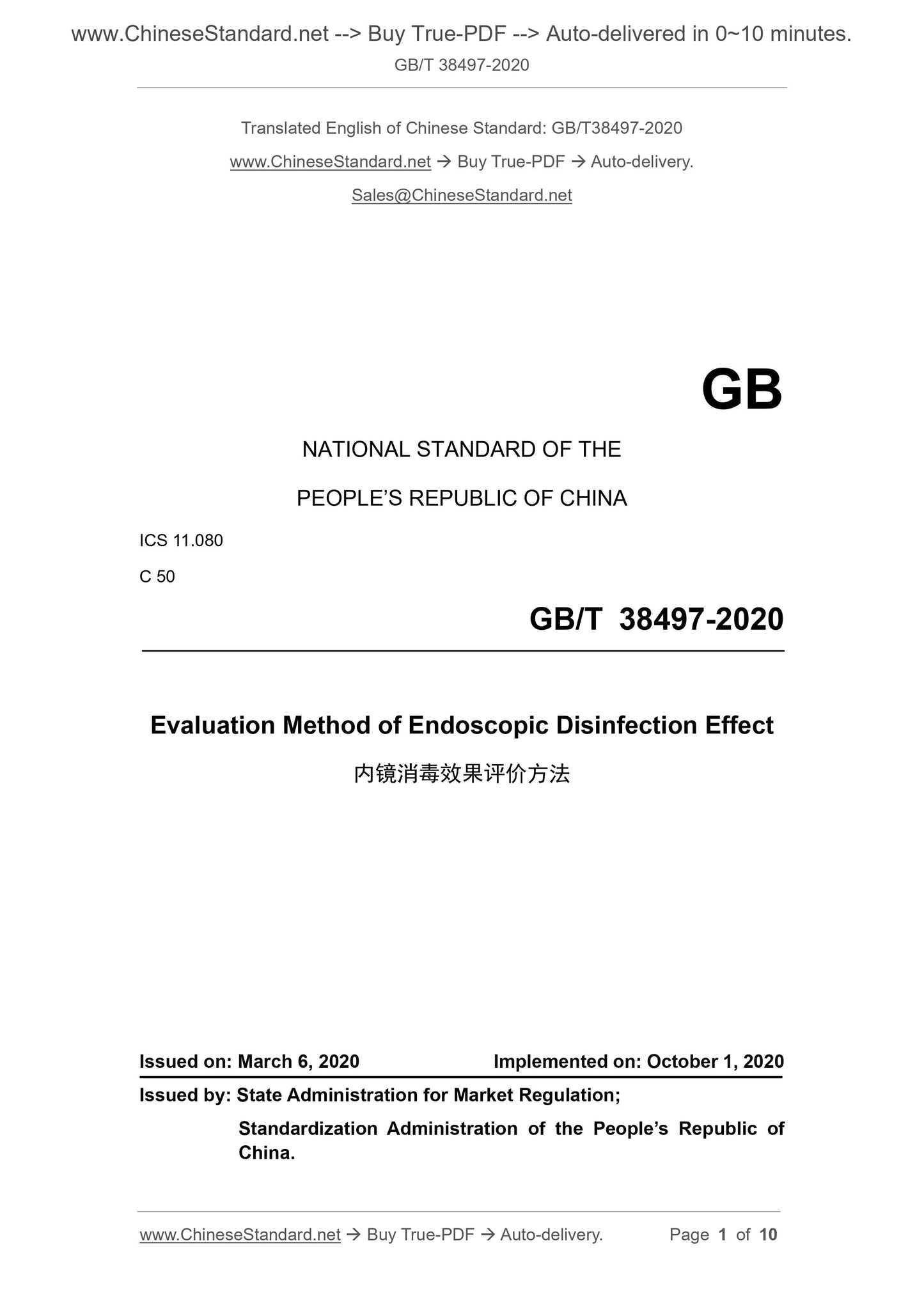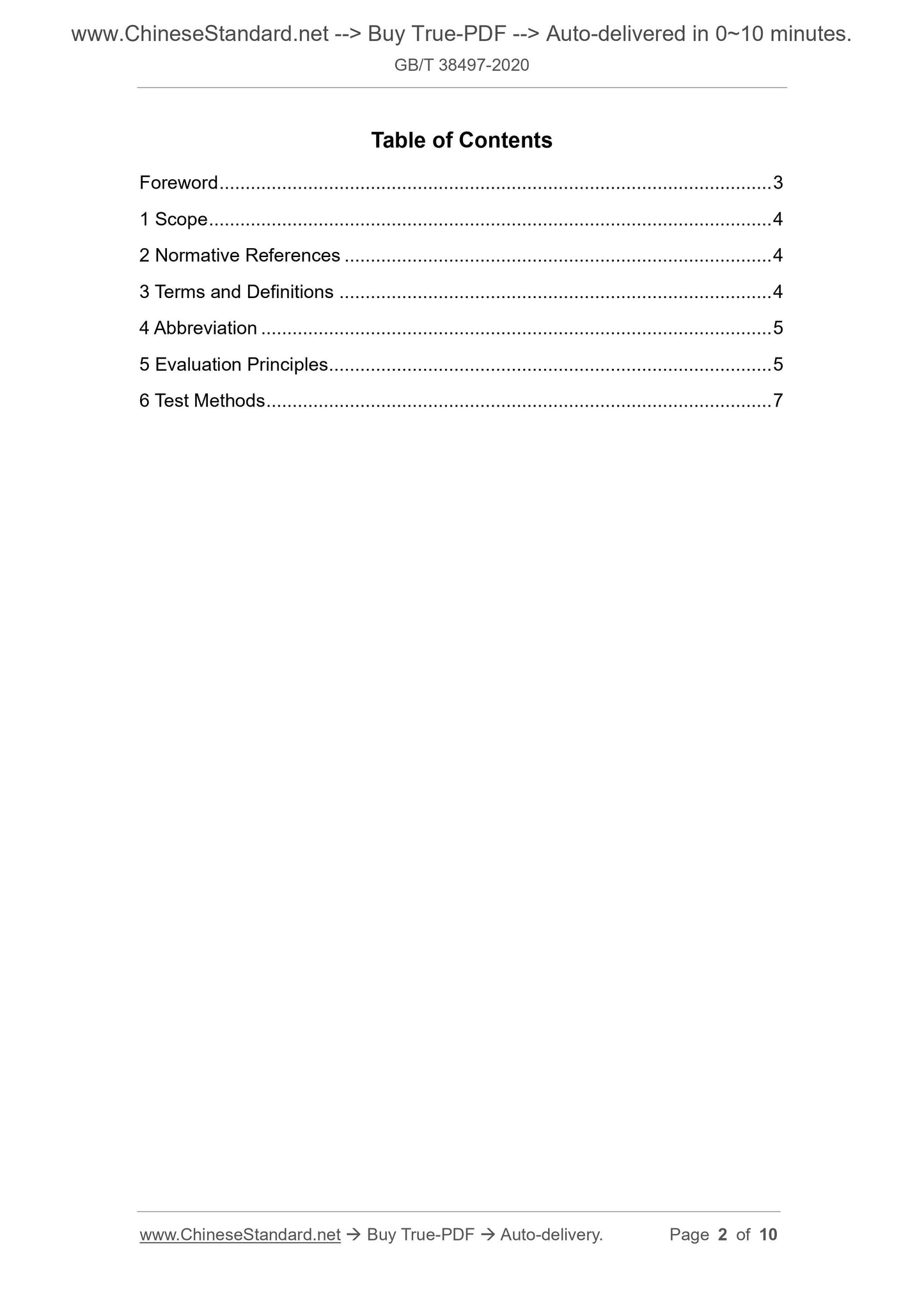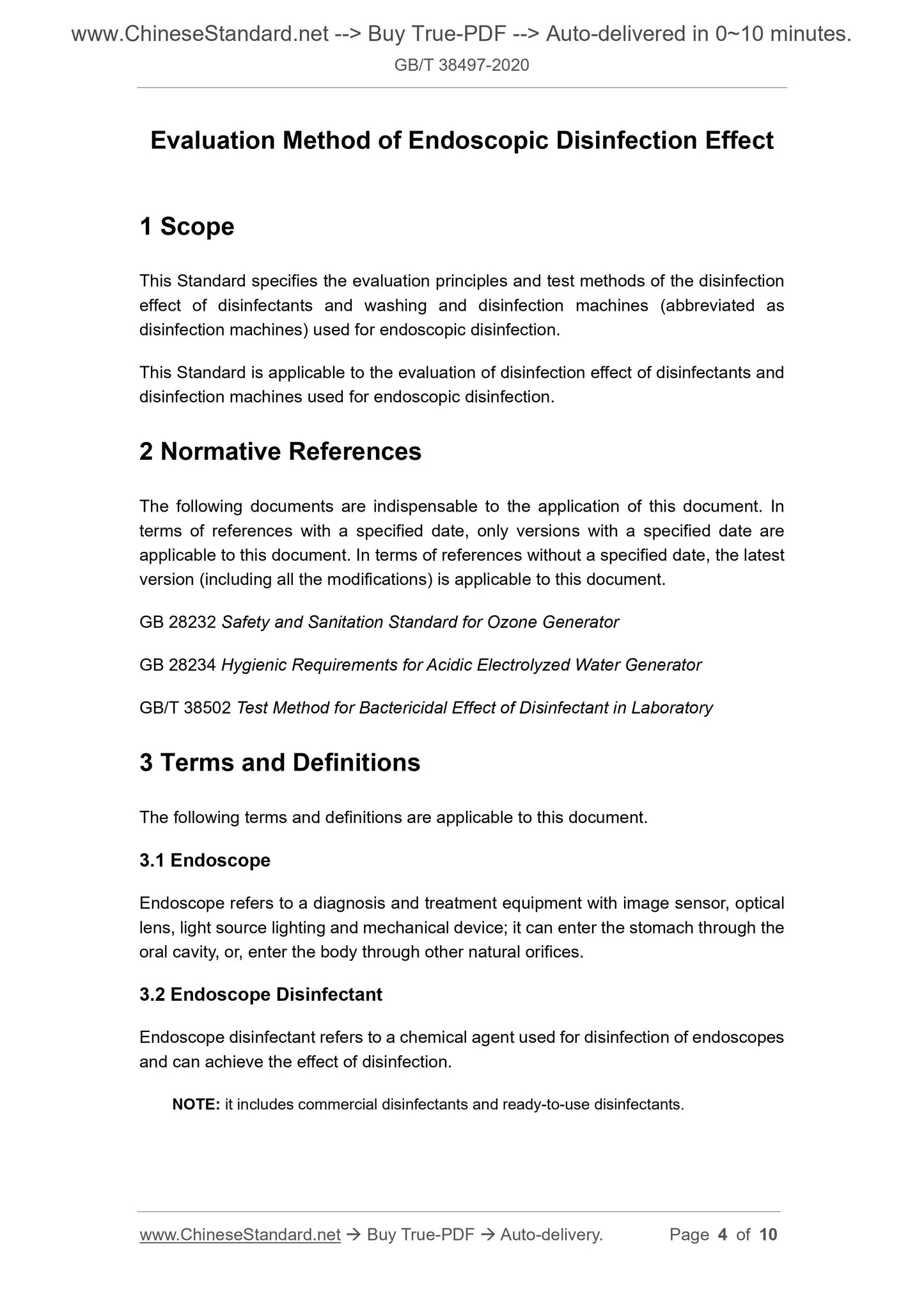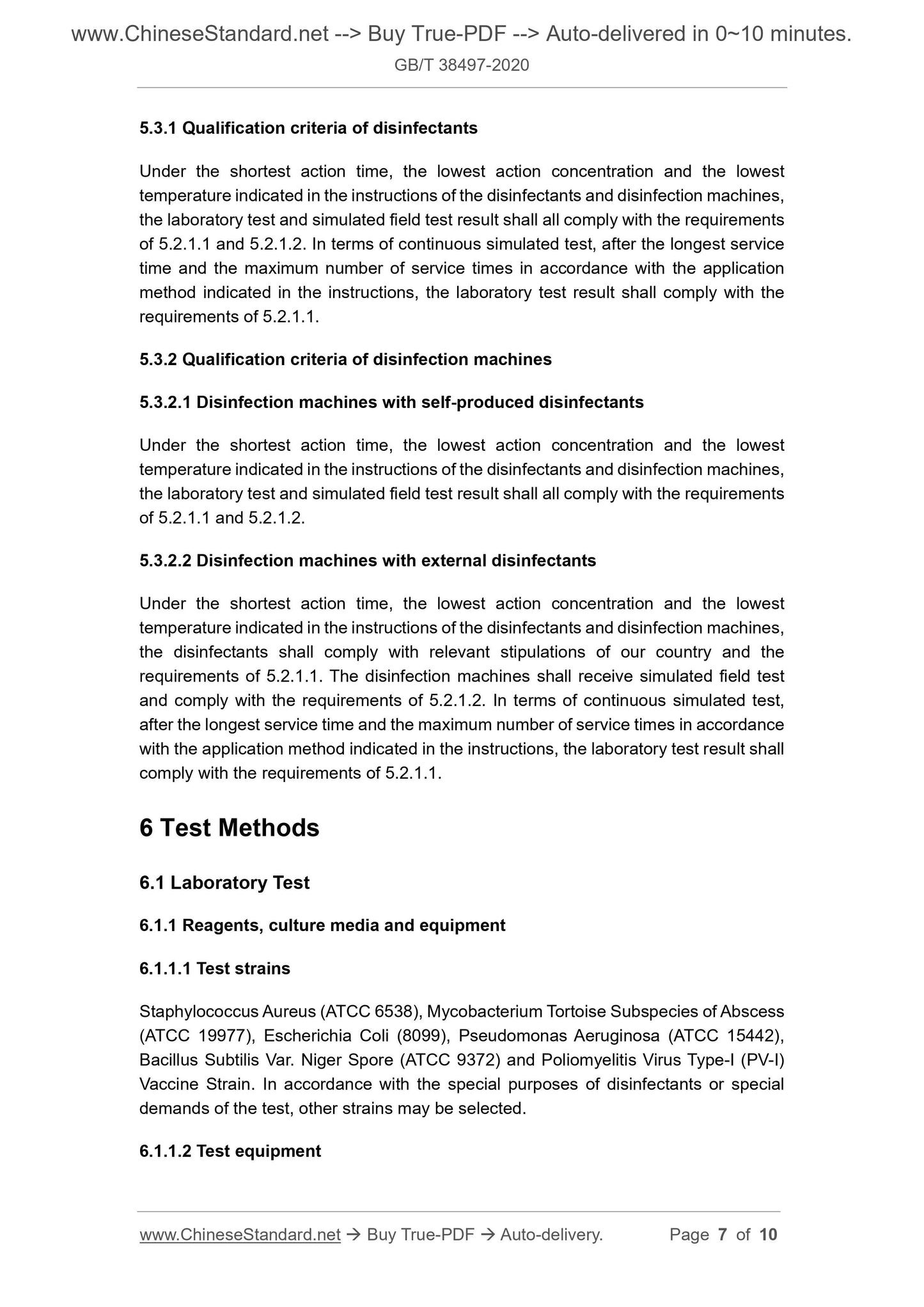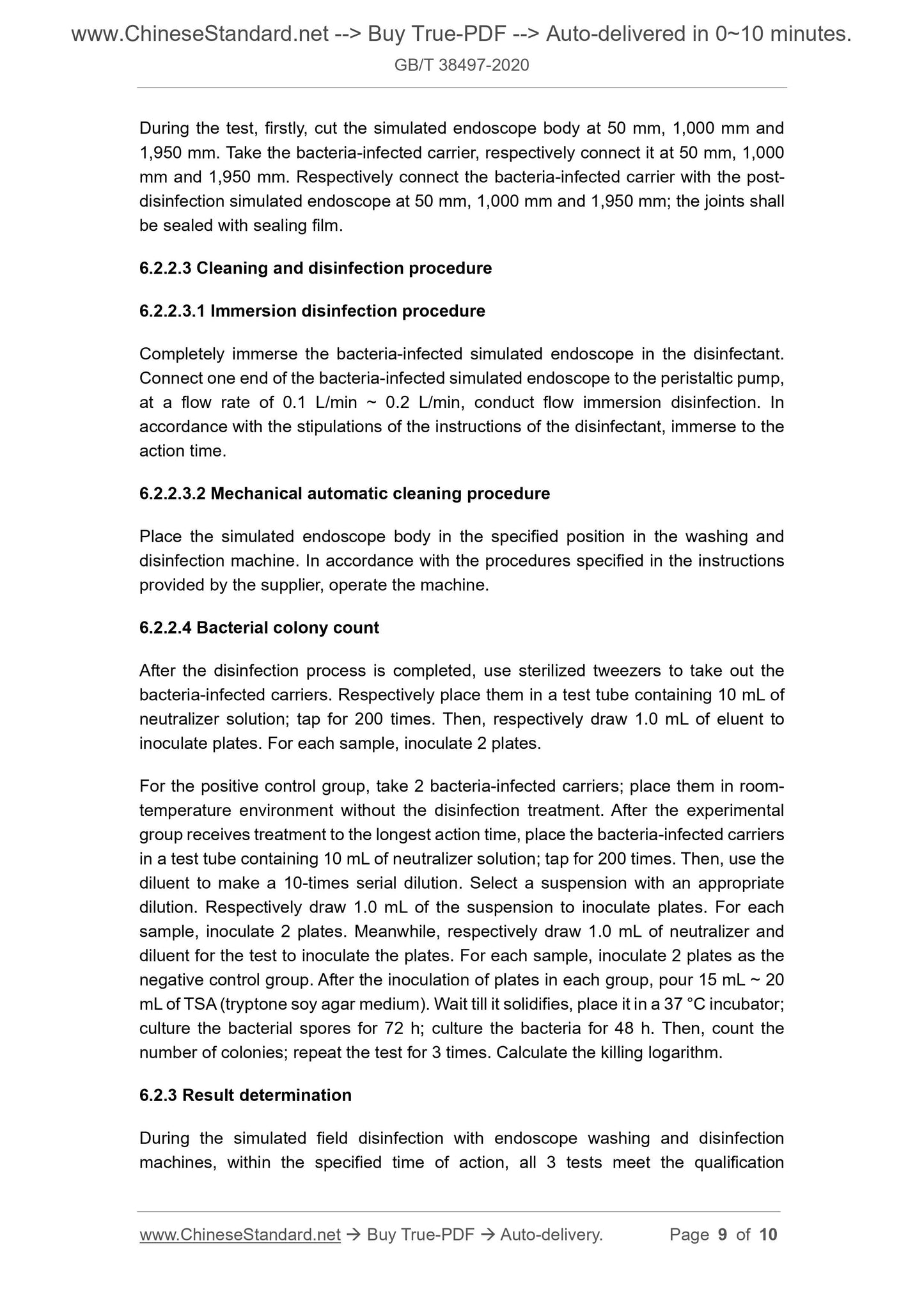1
/
of
5
PayPal, credit cards. Download editable-PDF & invoice in 1 second!
GB/T 38497-2020 English PDF (GBT38497-2020)
GB/T 38497-2020 English PDF (GBT38497-2020)
Regular price
$105.00 USD
Regular price
Sale price
$105.00 USD
Unit price
/
per
Shipping calculated at checkout.
Couldn't load pickup availability
Delivery: 3 seconds. Download true-PDF + Invoice.
Get QUOTATION in 1-minute: Click GB/T 38497-2020
Historical versions: GB/T 38497-2020
Preview True-PDF (Reload/Scroll if blank)
GB/T 38497-2020: Evaluation method of endoscopic disinfection effect
GB/T 38497-2020
GB
NATIONAL STANDARD OF THE
PEOPLE’S REPUBLIC OF CHINA
ICS 11.080
C 50
Evaluation Method of Endoscopic Disinfection Effect
ISSUED ON: MARCH 6, 2020
IMPLEMENTED ON: OCTOBER 1, 2020
Issued by: State Administration for Market Regulation;
Standardization Administration of the People’s Republic of
China.
Table of Contents
Foreword ... 3
1 Scope ... 4
2 Normative References ... 4
3 Terms and Definitions ... 4
4 Abbreviation ... 5
5 Evaluation Principles ... 5
6 Test Methods ... 7
Evaluation Method of Endoscopic Disinfection Effect
1 Scope
This Standard specifies the evaluation principles and test methods of the disinfection
effect of disinfectants and washing and disinfection machines (abbreviated as
disinfection machines) used for endoscopic disinfection.
This Standard is applicable to the evaluation of disinfection effect of disinfectants and
disinfection machines used for endoscopic disinfection.
2 Normative References
The following documents are indispensable to the application of this document. In
terms of references with a specified date, only versions with a specified date are
applicable to this document. In terms of references without a specified date, the latest
version (including all the modifications) is applicable to this document.
GB 28232 Safety and Sanitation Standard for Ozone Generator
GB 28234 Hygienic Requirements for Acidic Electrolyzed Water Generator
GB/T 38502 Test Method for Bactericidal Effect of Disinfectant in Laboratory
3 Terms and Definitions
The following terms and definitions are applicable to this document.
3.1 Endoscope
Endoscope refers to a diagnosis and treatment equipment with image sensor, optical
lens, light source lighting and mechanical device; it can enter the stomach through the
oral cavity, or, enter the body through other natural orifices.
3.2 Endoscope Disinfectant
Endoscope disinfectant refers to a chemical agent used for disinfection of endoscopes
and can achieve the effect of disinfection.
NOTE: it includes commercial disinfectants and ready-to-use disinfectants.
5.3.1 Qualification criteria of disinfectants
Under the shortest action time, the lowest action concentration and the lowest
temperature indicated in the instructions of the disinfectants and disinfection machines,
the laboratory test and simulated field test result shall all comply with the requirements
of 5.2.1.1 and 5.2.1.2. In terms of continuous simulated test, after the longest service
time and the maximum number of service times in accordance with the application
method indicated in the instructions, the laboratory test result shall comply with the
requirements of 5.2.1.1.
5.3.2 Qualification criteria of disinfection machines
5.3.2.1 Disinfection machines with self-produced disinfectants
Under the shortest action time, the lowest action concentration and the lowest
temperature indicated in the instructions of the disinfectants and disinfection machines,
the laboratory test and simulated field test result shall all comply with the requirements
of 5.2.1.1 and 5.2.1.2.
5.3.2.2 Disinfection machines with external disinfectants
Under the shortest action time, the lowest action concentration and the lowest
temperature indicated in the instructions of the disinfectants and disinfection machines,
the disinfectants shall comply with relevant stipulations of our country and the
requirements of 5.2.1.1. The disinfection machines shall receive simulated field test
and comply with the requirements of 5.2.1.2. In terms of continuous simulated test,
after the longest service time and the maximum number of service times in accordance
with the application method indicated in the instructions, the laboratory test result shall
comply with the requirements of 5.2.1.1.
6 Test Methods
6.1 Laboratory Test
6.1.1 Reagents, culture media and equipment
6.1.1.1 Test strains
Staphylococcus Aureus (ATCC 6538), Mycobacterium Tortoise Subspecies of Abscess
(ATCC 19977), Escherichia Coli (8099), Pseudomonas Aeruginosa (ATCC 15442),
Bacillus Subtilis Var. Niger Spore (ATCC 9372) and Poliomyelitis Virus Type-I (PV-I)
Vaccine Strain. In accordance with the special purposes of disinfectants or special
demands of the test, other strains may be selected.
6.1.1.2 Test equipment
During the test, firstly, cut the simulated endoscope body at 50 mm, 1,000 mm and
1,950 mm. Take the bacteria-infected carrier, respectively connect it at 50 mm, 1,000
mm and 1,950 mm. Respectively connect the bacteria-infected carrier with the post-
disinfection simulated endoscope at 50 mm, 1,000 mm and 1,950 mm; the joints shall
be sealed with sealing film.
6.2.2.3 Cleaning and disinfection procedure
6.2.2.3.1 Immersion disinfection procedure
Completely immerse the bacteria-infected simulated endoscope in the disinfectant.
Connect one end of the bacteria-infected simulated endoscope to the peristaltic pump,
at a flow rate of 0.1 L/min ~ 0.2 L/min, conduct flow immersion disinfection. In
accordance with the stipulations of the instructions of the disinfectant, immerse to the
action time.
6.2.2.3.2 Mechanical automatic cleaning procedure
Place the simulated endoscope body in the specified position in the washing and
disinfection machine. In accordance with the procedures specified in the instructions
provided by the supplier, operate the machine.
6.2.2.4 Bacterial colony count
After the disinfection process is completed, use sterilized tweezers to take out the
bacteria-infected carriers. Respectively place them in a test tube containing 10 mL of
neutralizer solution; tap for 200 times. Then, respectively draw 1.0 mL of eluent to
inoculate plates. For each sample, inoculate 2 plates.
For the positive control group, take 2 bacteria-infected carriers; place them in room-
temperature environment without the disinfection treatment. After the experimental
group receives treatment to the longest action time, place the bacteria-infected carriers
in a test tube containing 10 mL of neutralizer solution; tap for 200 times. Then, use the
diluent to make a 10-times serial dilution. Select a suspension with an appropriate
dilution. Respectively draw 1.0 mL of the suspension to inoculate plates. For each
sample, inoculate 2 plates. Meanwhile, respectively draw 1.0 mL of neutralizer and
diluent for the test to inoculate the plates. For each sample, inoculate 2 plates as the
negative control group. After the inoculation of plates in each group, pour 15 mL ~ 20
mL of TSA (tryptone soy agar medium). Wait till it solidifies, place it in a 37 °C incubator;
culture the bacterial spores for 72 h; culture the bacteria for 48 h. Then, count the
number of colonies; repeat the test for 3 times. Calculate the killing logarithm.
6.2.3 Result determination
During the simulated field disinfection with endoscope washing and disinfection
machines, within the specified time of action, all 3 tests meet the qualification
Get QUOTATION in 1-minute: Click GB/T 38497-2020
Historical versions: GB/T 38497-2020
Preview True-PDF (Reload/Scroll if blank)
GB/T 38497-2020: Evaluation method of endoscopic disinfection effect
GB/T 38497-2020
GB
NATIONAL STANDARD OF THE
PEOPLE’S REPUBLIC OF CHINA
ICS 11.080
C 50
Evaluation Method of Endoscopic Disinfection Effect
ISSUED ON: MARCH 6, 2020
IMPLEMENTED ON: OCTOBER 1, 2020
Issued by: State Administration for Market Regulation;
Standardization Administration of the People’s Republic of
China.
Table of Contents
Foreword ... 3
1 Scope ... 4
2 Normative References ... 4
3 Terms and Definitions ... 4
4 Abbreviation ... 5
5 Evaluation Principles ... 5
6 Test Methods ... 7
Evaluation Method of Endoscopic Disinfection Effect
1 Scope
This Standard specifies the evaluation principles and test methods of the disinfection
effect of disinfectants and washing and disinfection machines (abbreviated as
disinfection machines) used for endoscopic disinfection.
This Standard is applicable to the evaluation of disinfection effect of disinfectants and
disinfection machines used for endoscopic disinfection.
2 Normative References
The following documents are indispensable to the application of this document. In
terms of references with a specified date, only versions with a specified date are
applicable to this document. In terms of references without a specified date, the latest
version (including all the modifications) is applicable to this document.
GB 28232 Safety and Sanitation Standard for Ozone Generator
GB 28234 Hygienic Requirements for Acidic Electrolyzed Water Generator
GB/T 38502 Test Method for Bactericidal Effect of Disinfectant in Laboratory
3 Terms and Definitions
The following terms and definitions are applicable to this document.
3.1 Endoscope
Endoscope refers to a diagnosis and treatment equipment with image sensor, optical
lens, light source lighting and mechanical device; it can enter the stomach through the
oral cavity, or, enter the body through other natural orifices.
3.2 Endoscope Disinfectant
Endoscope disinfectant refers to a chemical agent used for disinfection of endoscopes
and can achieve the effect of disinfection.
NOTE: it includes commercial disinfectants and ready-to-use disinfectants.
5.3.1 Qualification criteria of disinfectants
Under the shortest action time, the lowest action concentration and the lowest
temperature indicated in the instructions of the disinfectants and disinfection machines,
the laboratory test and simulated field test result shall all comply with the requirements
of 5.2.1.1 and 5.2.1.2. In terms of continuous simulated test, after the longest service
time and the maximum number of service times in accordance with the application
method indicated in the instructions, the laboratory test result shall comply with the
requirements of 5.2.1.1.
5.3.2 Qualification criteria of disinfection machines
5.3.2.1 Disinfection machines with self-produced disinfectants
Under the shortest action time, the lowest action concentration and the lowest
temperature indicated in the instructions of the disinfectants and disinfection machines,
the laboratory test and simulated field test result shall all comply with the requirements
of 5.2.1.1 and 5.2.1.2.
5.3.2.2 Disinfection machines with external disinfectants
Under the shortest action time, the lowest action concentration and the lowest
temperature indicated in the instructions of the disinfectants and disinfection machines,
the disinfectants shall comply with relevant stipulations of our country and the
requirements of 5.2.1.1. The disinfection machines shall receive simulated field test
and comply with the requirements of 5.2.1.2. In terms of continuous simulated test,
after the longest service time and the maximum number of service times in accordance
with the application method indicated in the instructions, the laboratory test result shall
comply with the requirements of 5.2.1.1.
6 Test Methods
6.1 Laboratory Test
6.1.1 Reagents, culture media and equipment
6.1.1.1 Test strains
Staphylococcus Aureus (ATCC 6538), Mycobacterium Tortoise Subspecies of Abscess
(ATCC 19977), Escherichia Coli (8099), Pseudomonas Aeruginosa (ATCC 15442),
Bacillus Subtilis Var. Niger Spore (ATCC 9372) and Poliomyelitis Virus Type-I (PV-I)
Vaccine Strain. In accordance with the special purposes of disinfectants or special
demands of the test, other strains may be selected.
6.1.1.2 Test equipment
During the test, firstly, cut the simulated endoscope body at 50 mm, 1,000 mm and
1,950 mm. Take the bacteria-infected carrier, respectively connect it at 50 mm, 1,000
mm and 1,950 mm. Respectively connect the bacteria-infected carrier with the post-
disinfection simulated endoscope at 50 mm, 1,000 mm and 1,950 mm; the joints shall
be sealed with sealing film.
6.2.2.3 Cleaning and disinfection procedure
6.2.2.3.1 Immersion disinfection procedure
Completely immerse the bacteria-infected simulated endoscope in the disinfectant.
Connect one end of the bacteria-infected simulated endoscope to the peristaltic pump,
at a flow rate of 0.1 L/min ~ 0.2 L/min, conduct flow immersion disinfection. In
accordance with the stipulations of the instructions of the disinfectant, immerse to the
action time.
6.2.2.3.2 Mechanical automatic cleaning procedure
Place the simulated endoscope body in the specified position in the washing and
disinfection machine. In accordance with the procedures specified in the instructions
provided by the supplier, operate the machine.
6.2.2.4 Bacterial colony count
After the disinfection process is completed, use sterilized tweezers to take out the
bacteria-infected carriers. Respectively place them in a test tube containing 10 mL of
neutralizer solution; tap for 200 times. Then, respectively draw 1.0 mL of eluent to
inoculate plates. For each sample, inoculate 2 plates.
For the positive control group, take 2 bacteria-infected carriers; place them in room-
temperature environment without the disinfection treatment. After the experimental
group receives treatment to the longest action time, place the bacteria-infected carriers
in a test tube containing 10 mL of neutralizer solution; tap for 200 times. Then, use the
diluent to make a 10-times serial dilution. Select a suspension with an appropriate
dilution. Respectively draw 1.0 mL of the suspension to inoculate plates. For each
sample, inoculate 2 plates. Meanwhile, respectively draw 1.0 mL of neutralizer and
diluent for the test to inoculate the plates. For each sample, inoculate 2 plates as the
negative control group. After the inoculation of plates in each group, pour 15 mL ~ 20
mL of TSA (tryptone soy agar medium). Wait till it solidifies, place it in a 37 °C incubator;
culture the bacterial spores for 72 h; culture the bacteria for 48 h. Then, count the
number of colonies; repeat the test for 3 times. Calculate the killing logarithm.
6.2.3 Result determination
During the simulated field disinfection with endoscope washing and disinfection
machines, within the specified time of action, all 3 tests meet the qualification
Share
